|
Elpida Hadzi-Vasileva, Silentio
Pathologia, Entrance to the Exhibition at the Venice Biennale. Photo: Marjorie Och.
Elpida Hadzi-Vasileva Silentio Pathologia
Macedonia at the 55th Venice Biennale
By Marjorie Och
The year is 1348. Europe is about to meet its worst enemy.
Within a few years, nearly two-thirds of the population of the continent is dead. The cause? The Bubonic Plague. Rats were
host bodies...where rats travelled, the plague followed. Cities, towns, rural areas all experienced horrific devastation and
chaos. Those who survived the plague long-remembered this time as a period of sorrow, confusion, and absolute fear. In Silentio
Pathologia the artist Elpida Hadzi-Vasileva considers the rapid movement of the plague in early modern Europe, and finds
parallels to the transmission of viruses today.
Silentio Pathologia encompasses the entire
interior of the Scuola dei Laneri, the former confraternity of the wool workers in Venice. One might feel claustrophobic here
were it not for the natural light streaming in from the expansive windows along the entrance wall.
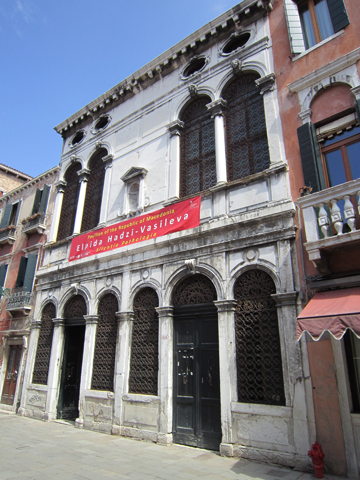
|
| Scuola dei Laneri. Photo: Marjorie Och |
The location was a lucky find and adds a layer of meaning to interpretations of the work. Wool
was one of the many products Venetians transported across early modern Europe, unwittingly playing a significant role in the
transmission of plague.
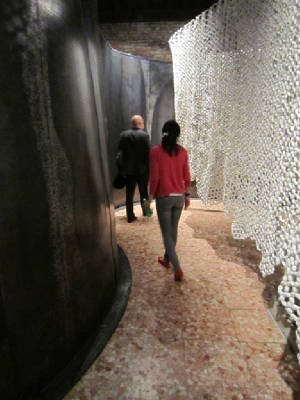
|
| The journey begins. Photo: Marjorie Och. |
The visitor to the Scuola dei Laneri today also journeys. At the entrance of the
Scuola one encounters the opening of a path marked by a metal wall about 10’ high at the left (two and a half tons of
metal all told), and at the right a drape of silkworm cocoons threaded together. Here, one’s journey begins. The metal
is imposing -- most remains untouched but some surface areas show the effects of being worked in a circular motion by a grinder.
The metal surface also receives the patterned shadows cast by the threaded cocoons.
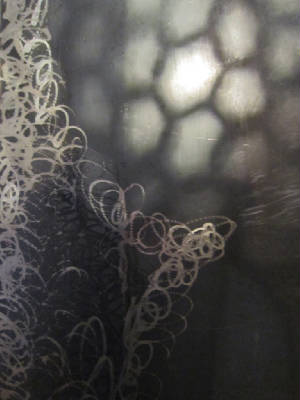
|
| Silentio Pathologia, detail of metal wall. Photo: Marjorie Och. |
The visitor walks between
the wall of metal and drape of cocoons in a vaguely circular journey that leads
to new walls -- one made of unprocessed black silk threads stitched together by
the artist and the other wall a drape of albino rat pelts, also stitched
together by the artist.
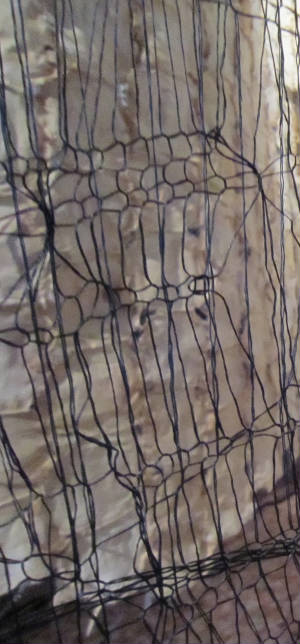
|
| Silentio Pathologia, detail of silk curtain. Photo: Marjorie Och. |
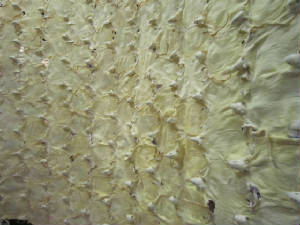
|
| Silentio Pathologia, detail of rat pelts. Photo: Marjorie Och. |
In early modern Europe, rats
were carriers of disease. Today they are among the most common living creatures
in research labs for the study of disease. At the center of Silentio Pathologia are two cages with
pet rats. As the artist explained, the rats need to be held and stroked every
day, preferably by the same person because the rats become familiar with one’s
scent and like it; this care insures that the rats remain tamed and do not
revert to their wild state. At the heart of this journey we come face to face
with a dilemma -- taming our fears requires embracing them.
After one’s journey is complete,
one may return to marvel at the details. The massive metal wall now appears to
be as much a drape as the cocoons, rat pelts, or raw silk – the weight of the
metal disappearing behind the beauty of its curves and patterns. We look more
closely at the cocoons and see that they are not all the same. According to the
artist, their colors vary because some still held the silk worms and the reds
and oranges we see are their bodily fluids. (Conversation with the artist, May
28, 2013.) Looking now at the rat pelts, we begin to see the individuality of
these hybridized lab creatures – their fur is not merely white, each one exhibits
shades of cream to suggest a subtle chiaroscuro
against the striking tenebrism of the
metal. And their tanned sides, equally varied, challenge definition by color.
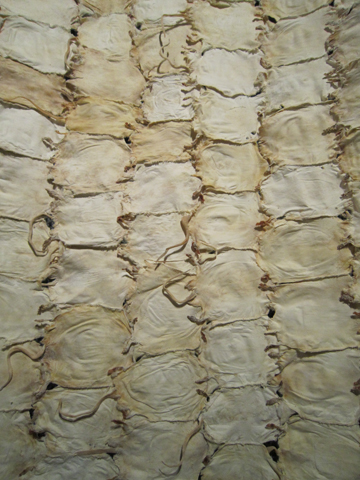
|
| Silentio Pathologia, detail, tanned rats. Photo: Marjorie Och. |
Elpida
Hadzi-Vasileva’s Silentio Pathologia is one of the more
interesting installations at the 55th Venice Biennale. This is a
work to experience, not merely an accumulation of materials to look at. Hadzi-Vasileva’s
installation
succeeds both as a structure and as an idea. The visitor is drawn into a space,
and that space is transformed by the artist’s work. We forget the bricks and
mortar of the Scuola as we transition
from one material, be it metal, silk, fur, or tanned skin, to another. We see
familiar objects in new ways. Silk, usually woven into a textile, here
surrounds us in unfamiliar and unexpected formats. And if we touch the raw
black silk woven into a curtain, we find that it sticks to us and we transform
it. The rats, too, are both familiar and strange. From a distance, this drape appears
to be a quilted textile -- until we see faces and tails. This brings us –
literally face to face – with both a cause and a victim of disease. Elpida
Hadzi-Vasileva’s work
encourages the viewer to travel across time. Leaving the Scuola one might contemplate life in Venice, the most cosmopolitan
city in fourteenth-century Europe, besieged by plague. Our thoughts then turn to global travel today
where we are hours, rather than months, from our next port of call.
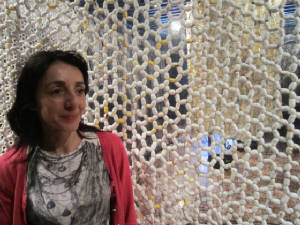
|
| Elpida Hadzi-Vasileva, Silentio Pathologia. Photo: Marjorie Och. |
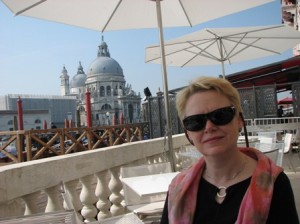
Marjorie Och writes about early modern
and contemporary art. She is professor of art history at the University of Mary Washington in Fredericksburg, VA.
|
